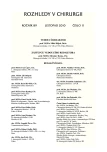Posttraumatic Atlantoaxial Rotatory Fixation in a Child
Authors:
P. Kľoc; Ľ. Tomčovčík; S. Vyskočová *
Authors‘ workplace:
Klinika úrazovej chirurgie, FNsP J. A. Reimana, Prešov, Slovenská republika
prednosta MUDr. Ľ. Tomčovčík, Ph. D.
; Rádiologické oddelenie, NsP Bardejov, Slovenská republika, primár MUDr. A. Havrilla
*
Published in:
Rozhl. Chir., 2010, roč. 89, č. 11, s. 659-662.
Category:
Monothematic special - Original
Overview
Traumatic atlantoaxial rotatory fixation is defined as low-energy mechanism injury resulting in fixed subluxation of the atlantoxial complex expressing oneself as a slight head flexion, lateral tilt of the head to one side, head rotation to the other side and painful limitation of motion that makes it impossible to turn head to the contralateral side voluntary. As a result of the rarity of the injury it is often neglected, treated improperly, treated for the duration, or it has permanent consequences. We present a case report of a 10 year old patient treated in our department with acute traumatic atlantoaxial rotatory fixation. The diagnosis was made on the basis of synthesis of anamnestic data, clinical picture and static CT examination. The patient was successfully treated conservatively. In the discussion we present a brief look at the etiopathogenesis, diagnosis and treatment of the injury. Its pathogenesis is still not fully understood. The most reliable diagnostic methods are dynamic X-ray and dynamic CT examinations. In our discussion, more is dedicated to clinical diagnostics, and static X-ray and CT examinations as a way likely to lead together with anamnestic data on the accident at the correct diagnosis even in the absence of acute dynamic CT or X-ray examinations. The treatment of acute traumatic atlantoaxial rotatory fixation is usually indicated for conservative treatment, with excellent results. Neglected cases generally require surgical intervention. Treatment of neglected atlantoaxial rotatory fixation is usually difficult and permanently distorting anatomical growing organism.
Key words:
traumatic atlantoaxial rotatory fixation – children – computer tomography
Sources
1. Kowalski, H. M., Cohen, W. A., Cooper, P., Wisoff, J. H. Pitfalls in the CT diagnosis of atlantoaxial rotary subluxation. AJR, 1987; 149: 595–600.
2. Fielding, J. W., Hawkins, R. J. Atlanto-axial rotatory fixation: fixed rotatory subluxation of the atlanto-axial joint. J. Bone Joint Surg., 1977; 59: 37–44.
3. Karkos, P. D., Benton, J., Leong, S. C., Mushi, E., Sivaji, N., Assimakopoulos, D. A. Grisel‘s syndrome in otolaryngology: A systematic review. Int. J. Pediatr. Otorhinolaryngol., 2007; 71: 1823–1827.
4. van Hosbeeck, E. M. A., Mackay, N. N. S. Diagnosis of acute atlantoaxial rotatory fixation. J. Bone Joint Surg., 1989; 71: 90–91.
5. Subach, B. R., McLaughlin, M. R., Albright, A. L., Pollack, I. F. Current management of pediatric atlantoaxial rotatory subluxation. Spine, 1998; 23: 2174–2179.
6. Osenbach, R. K., Menezes, A. H. Pediatric spinal cord and vertebral column injury: experimental and clinical study. Neurosurgery, 2002; 30: 385–390.
7. Abrar, A. W., Tanveer, A. D. M. B., Altaf, U. R., Altaf, R. K., Abdul, R. B. Craniovertebral junction injuries in children. A Review. Indian Journal of Neurotrauma, 2007; 4: 79–87.
8. Wortzman, G., Dewar, F. P. Rotary fixation of the atlantoaxial joint: rotational atlantoaxial subluxation. Radiology, 1968; 90: 479–487.
9. Sudek, P. Ueber drehnungsverrenkung des atlas. Dtsch. Z. Chir., 1923; 183: 289–303.
10. Fielding, J. W. Cineradiography of the normal cervical spine. J. Bone Joint Surg., 1957; 39: 1280–1288.
11. Villas, C., Arriagada, C., Zubieta, J. L. Preliminary CT study of C1 – C2 rotational mobility in normal subjects. European Spine Journal, 1999; 8: 223–228.
12. Pang, D., Li, V. Atlantoaxial rotatory fixation: Part 3 of a prospective study of the clinical manifestation, diagnosis, management, and outcome of children with atlantoaxial rotatory fixation. Neurosurg., 2005; 5: 954–971.
13. Phillips, W. A., Hensinger, R. The management of rotatory atlanto-axial subluxation in children. J. Bone Joint Surg., 1989; 71: 664–668.
Labels
Surgery Orthopaedics Trauma surgeryArticle was published in
Perspectives in Surgery

2010 Issue 11
- Metamizole at a Glance and in Practice – Effective Non-Opioid Analgesic for All Ages
- Metamizole vs. Tramadol in Postoperative Analgesia
- Current Insights into the Antispasmodic and Analgesic Effects of Metamizole on the Gastrointestinal Tract
Most read in this issue
- Mucinous Adenocarcinoma of the Appendix – Case Report
- Abdominal Catastrophe – Abdominal Wall Defect Associated with Gastrointestinal Fistula – Strategy of Therapy
- Five-Year Follow up in Patients after Surgery for Clear Cell Renal Carcinoma
- Torsion of the Omentum – An Uncommon Cause of Acute Abdomen
